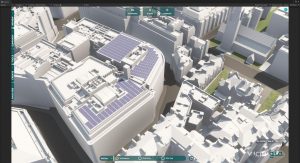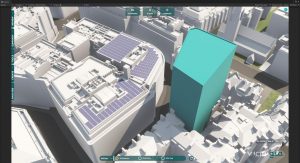Renewable energy, particularly solar photovoltaic (PV), has gained significant attention from governments, businesses, and individuals as they address the challenges of climate change. In June 2019, the UK government legislated a net zero emissions target by 2050. To support this, the government set two interim targets for 2035: achieving a net zero power system and reducing emissions by 78%.
The assessment of suitable properties for solar PV installations and their energy-generation potential is crucial for maximising solar PV benefits. This is where GIA’s solar photovoltaic assessment comes into play. We have developed advanced technology and expertise to assess 56 properties in Belfast after winning a research grant for a pilot scheme awarded by the Department for the Economy in Northern Ireland. The results of our assessment hold significant implications for climate change policies and renewable energy strategies. Our pilot project in Belfast was awarded Highly Commended in the Climate Initiative of the Year at the recent Belfast Telegraph Property Awards.

At the heart of GIA’s solar photovoltaic assessment is a unique approach to 3D modelling and spatial analysis. We acquired roofscapes through VUCITY, a highly accurate 3D digital model of cities built from high-resolution aerial imagery. The roofscape accuracy down to 15cm, has crucially allowed us to evaluate the net usable area for solar PV, avoiding the widespread assumption that roofs are somewhat equivalent in area to building footprints. Starting from accurate rooftops, GIA have developed automated algorithms capable of packing the optimised number of panels on any orientation and type of roof. Our shading calculations as well as the use of local climate data, further increases the accuracy of results by several factors, resulting in better power, carbon, cost and payback estimates.
With this approach, we can deliver solar PV at scale, empowering local authorities, developers and asset managers to quantify the cost and payback of installing solar PV panels as part of their Net Zero Preventive Plans. This would enable clients to secure grants based on evidence and prioritise installations where they are most needed. This allows us to look beyond individual properties and assess entire portfolios, helping shape policies and tariffs at a ward or city level.
The results of the project demonstrate the potential for solar PV across a wide range of properties. The 56 properties assessed in Belfast were a mix of both domestic and non-domestic, including two car park sites. By analysing each property individually, we could identify which properties were more suitable for installations. This data represents a vital first step in informing climate change policies and renewable energy strategies in response to Northern Ireland’s recently introduced Climate Change Act (Northern Ireland) 2021.
Claire Shortt, Monitoring, Learning and Reporting Officer in Belfast City Council’s Climate Team said:
The project aim was to explore the solar generation potential of local government properties in Belfast. GIA’s expertise in daylight, sunlight and solar ensured the project was a great success, providing a technical analysis at scale, with individual property level accuracy on not only the solar generation potential, but numerous other key variables, including carbon and payback forecasts.
Read the project report here.
We have now been commissioned for Phase 2 of the project. This involves scaling up from ca. 60 properties (Phase 1 – pilot) to the testing of 25 separate Data Zones within Belfast. This equates to ca.3 Km2 of the city’s rooftops being analysed with best-in-class accuracy. Data Zones represent the latest statistical research output geographies related to the 2021 Census.
Phase 2 aims to establish the potential energy generation for each of the Zones. The study will determine the size of the system, the number of PV panels, the CO2 reduction the estimated costs and payback period, along with an interactive toolkit to facilitate scenario modelling, panel performance filtering and viability assessment.
Estimating the capacity for Solar PVs in Data Zones will be a vital evidence-based information tool for both the DfE and BCC, in their joint efforts to deliver and promote renewable sources of energy across Belfast.
With significant potential to support the drive towards net zero, we look forward to sharing more on this exciting project as it moves forward.
To discuss this project or our Solar PV services in more detail, contact Simone Pagani or Kevin Francis.





